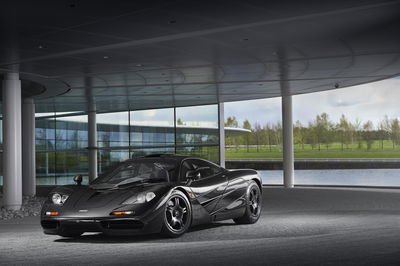The Gordon Murray T.50 Makes The McLaren F1 Look Compromised

When you hear or read the words ‘McLaren F1,’ referring to the legendary road car of the 1990s that brought a thoroughbred, ultra-lightweight and ridiculously focused race-born mentality to the road, you think of greatness.
You think, despite none of us ever having driven one, of lightness, of tactility on another level, of frighteningly fast responses and of a high-revving, race-derived V12 engine. It encapsulated the 1990s pursuit of speed, surpassing everything that went before it and everything that came after – in some ways, at least.
Forced induction added higher top speeds but no one – absolutely nobody – could match the F1’s power-to-lightness approach. To have something that weighed about the same as a small hatchback powered by an orchestral mid-mounted BMW V12 loaded with 618bhp was – and is – bonkers. It accelerated and handled with such outrageous immediacy that it put testers in mind of what it would be like to be miniaturised and ride a flea.
And yet, for all its designer Gordon Murray’s obsessive attention to detail in partnership with then McLaren boss Ron Dennis, it was compromised. The engine couldn’t be a purpose-built, in-house affair. The BMW unit, although incredible, borrowed from the M parts bin in ways that perhaps McLaren wouldn’t have, given unlimited money.

Technological boundaries also restricted the F1. There was simply no way to achieve the target sub-1000kg weight figure as things were, without reducing the whole (already compact) car to nine-tenths scale. As a result, some of Murray’s clever F1 aero tech that had been bouncing around the sport, often getting banned for being too effective, was left out of the equation.
Yes, the F1 pioneered ground-effect downforce in road cars and yes, it did tick every last box attached to the title of ‘best car ever,’ but Murray, we think, always knew he could do even better. Well, ladies and gents, better is coming.

You should have seen earlier this week (and if not, where were you?!) that Murray has come up with a McLaren F1 successor called the T.50. Arguably it’s the only true successor ever to the mighty F1, albeit under his own brand. Some 25 years separate the F1’s launch and the announcement of the T.50’s first vital stats, but my, Murray has got something to show for it.
The T.50 will be a carbon-tubbed, carbon-bodied jamboree of exotic lightweighting. Like the F1 it’s a three-seater with the driver positioned centrally and the passengers staggered behind on either side. Like the F1 it’s manual, it has a mad V12 and is built to outdo just about everything else in the automotive stratosphere.

Take the 3.9-litre V12 that revs higher than a lot of motorbikes: 12,100rpm. Or take the weight figure: just 980kg of insurer-terrifying ubercar presses down through its sticky tyres. That’s about the weight of the latest Suzuki Swift Sport and 120kg less than the F1. The little Suzuki has 138bhp and is a proper giggle; the bespoke Cosworth-developed V12 in the T.50 has 650bhp. Power to weight? That’s 663bhp per tonne. There is no way you could extract the maximum out of it without being an elite pro racer.
What’s more, we can expect “a completely new domain” for aero, says Murray, who promises “absolutely the most advanced aerodynamics ever seen on a road car.” With Aston Martin working on the Valkyrie and Mercedes-AMG working on the One, that’s quite the boast.

Tech will even come from the 1978 Brabham BT46 ‘fan car’, designed by Murray for the then team boss Bernie Ecclestone. Its most radical aspect was the giant fan at the rear, introduced part-way through the season for a single race and then dropped because lead driver Niki Lauda didn’t like the handling, despite winning the Swedish Grand Prix with it.
It was swiftly banned, anyway, and legislators in Europe wouldn’t be too keen to let it loose on public roads. Elsewhere the car used flat-panel heat exchangers in place of radiators, which helped lighten and shrink the porky package but, at the time, didn’t really cool the huge flat-12 Alfa Romeo engine much. They were binned as well, but could a comeback be on in the T.50?
Don’t let the T.50’s ability to carry passengers distract you. This is a racing car for the road and it takes the dizzying mentality of the F1 to new heights. We’ve spent so long believing that the F1 was a one-off, an incalculably special moment in car history that could never be repeated in these anti-combustion times, that we never imagined something quite like the T.50 would happen.
It’s yet to prove itself but the recipe is one that promises a new watershed moment for young car enthusiasts. The F1 legend is being reborn with its few compromises eradicated. One of the greatest cars ever made is about to get even better: what a time to be a gearhead.














Comments
While he has the honour of having a CBE, I still think he deserves a Knighthood for all his work.
Murray and Koenigsegg really are the Elon Musks of the petrolhead world.
We really need more Musks of the petrolhead world…
I think that theyre better than musk because theyre companies dont have financial trouble
لا يمكن أن تنتظر للكشف يا إلهي !!!
thog don’t speaak bomb
Naturally aspirated V12 that revs to 12k rpm, mid-mounted in a car that weights 980kg
I don’t care about anything else, this is a masterpiece already
correction: the BT46 fan car come with an Alfa Romeo engine, instead of a Maserati engine.
Manual???? Is this a dream? Did I read that right?
It’s 2019 and the industry is moving more towards electrification and automation and we have this brand that is making a hypercar with an N/A V12 and a manual transmission.
Me rn: